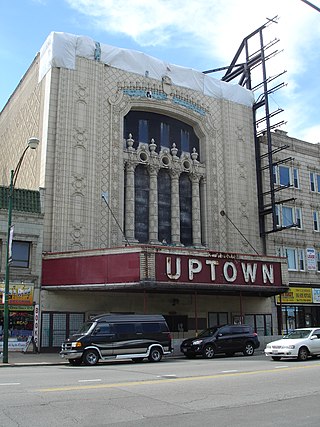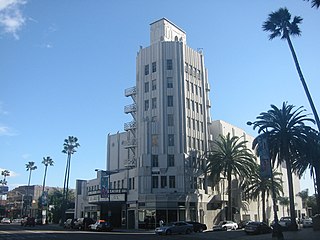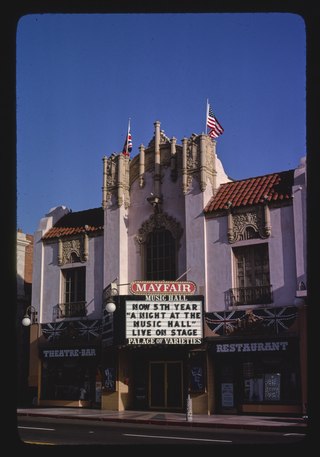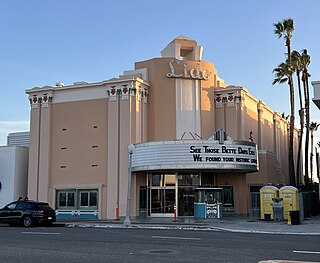
The Hollywood Palladium is a theater located at 6215 Sunset Boulevard in the Hollywood neighborhood of Los Angeles, California, United States. It was built in a Streamline Moderne, Art Deco style and includes an 11,200-square-foot (1,040 m2) dance floor including a mezzanine and a floor level with room for up to 4,000 people. The theater was listed on the National Register of Historic Places in 2016. The Palladium was designated Los Angeles Historic Cultural Monument No. 1130 on September 28, 2016.
The culture of Los Angeles is rich with arts and ethnically diverse. The greater Los Angeles metro area has several notable art museums including the Los Angeles County Museum of Art (LACMA), the J. Paul Getty Museum on the Santa Monica Mountains overlooking the Pacific, the Museum of Contemporary Art (MOCA), and the Hammer Museum. In the 1920s and 1930s Will Durant and Ariel Durant, Arnold Schoenberg and other intellectuals were the representatives of culture, in addition to the movie writers and directors. As the city flourished financially in the middle of the 20th century, culture followed. Boosters such as Dorothy Buffum Chandler and other philanthropists raised funds for the establishment of art museums, music centers and theaters. Today, the Southland cultural scene is as complex, sophisticated and varied as any in the world.

A movie palace is a large, elaborately decorated movie theater built from the 1910s to the 1940s. The late 1920s saw the peak of the movie palace, with hundreds opening every year between 1925 and 1930. With the advent of television, movie attendance dropped, while the rising popularity of large multiplex chains in the 1980s and 1990s signaled the obsolescence of single-screen theaters. Many movie palaces were razed or converted into multiple-screen venues or performing arts centers, though some have undergone restoration and reopened to the public as historic buildings.

The Saban Theatre is a historic theatre in Beverly Hills, California, formerly known as the Fox Wilshire Theater. It is an Art Deco structure at the southeast corner of Wilshire Boulevard and Hamilton Drive designed by architect S. Charles Lee and is considered a classic Los Angeles landmark. The building was listed on the National Register of Historic Places on April 3, 2012.

The Pellissier Building and adjoining Wiltern Theatre is a 12-story, 155-foot (47 m) Art Deco landmark at the corner of Wilshire Boulevard and Western Avenue in Los Angeles, California. The entire complex is commonly referred to as the Wiltern Center. Clad in a blue-green glazed architectural terra-cotta tile and situated diagonal to the street corner, the complex is considered one of the finest examples of Art Deco architecture in the United States. The Wiltern building is owned privately, and the Wiltern Theatre is operated by Live Nation's Los Angeles division.

Stiles Oliver Clements was an architect practicing in Los Angeles and Southern California.

The Million Dollar Theatre at 307 S. Broadway in Downtown Los Angeles is one of the first movie palaces built in the United States. It opened in 1917 with the premiere of William S. Hart's The Silent Man. It's the northernmost of the collection of historical movie palaces in the Broadway Theater District and stands directly across from the landmark Bradbury Building. The theater is listed in the National Register of Historic Places.

The Mayfair Music Hall was an English music hall-styled vaudeville theater devised and created by entrepreneur Milt Larsen, located in Santa Monica, California.

The Fox Theater Pomona is a fully restored Art Deco movie palace from Hollywood's golden age in Pomona, Los Angeles County, California. Today the Fox Theater Pomona is a state-of-the-art venue for concerts, cinema, performances, and parties. It is the flagship attraction of the Pomona Arts Colony, a vibrant neighborhood of galleries, nightclubs, lofts, and restaurants.

Timothy Ludwig Pflueger was an architect, interior designer and architectural lighting designer in the San Francisco Bay Area in the first half of the 20th century. Together with James R. Miller, Pflueger designed some of the leading skyscrapers and movie theaters in San Francisco in the 1920s, and his works featured art by challenging new artists such as Ralph Stackpole and Diego Rivera. Rather than breaking new ground with his designs, Pflueger captured the spirit of the times and refined it, adding a distinct personal flair. His work influenced later architects such as Pietro Belluschi.
S. Charles Lee was an American architect recognized as one of the most prolific and distinguished motion picture theater designers on the West Coast.

The Elks Lodge No. 99 / Park Plaza Hotel, now The MacArthur, is located at 607 Park View Street across from MacArthur Park in the Westlake district of Los Angeles, California. Completed in 1926, it was designed by architect Claud Beelman, later to become renowned an Art Deco designer, when he was practicing as Curlett + Beelman.

Walker & Eisen (1919−1941) was an architectural partnership of architects Albert R. Walker and Percy A. Eisen in Los Angeles, California.
Live From the Artists Den is a three-time New York Emmy-nominated music television series that features popular recording artists performing in non-traditional settings throughout North America. Live From the Artists Den broadcasts nationally on public television and internationally in the United Kingdom, Latin America, China, Japan, Germany, New Zealand, and Canada.

The Granada Theater is a theatre located in Lower Greenville, in Dallas, TX. The theatre was built in 1946 as a movie house. In 1977, it was converted to a concert hall, only to revert to a movie theater soon after. In 2004 it was again opened as a concert hall.

The Nimoy Theater, formerly known as Crest, Majestic Crest and Bigfoot Crest Theatre, is a movie theatre located in the Westwood neighborhood of Los Angeles, California. It was founded as the UCLAN in 1941, and was built for live performances but switched to a newsreel cinema during World War II. Through ownership changes, it has been known at various times as UCLAN Theatre, Crest Theatre, and Metro Theatre. The original 500-seat art deco style theater was designed by Arthur W. Hawes.

The Westlake Theatre is a historic theater located in the Westlake section of Los Angeles, California, United States, adjacent to MacArthur Park. The theater was listed on the National Register of Historic Places in 2009.

The Lido Theater is a historic single-screen movie theater in Newport Beach, California. The Lido Theater opened in October 1939 and was designed by Clifford A. Balch in the Art Deco architectural style. Edwards Theatres, Regency Theatres, and Laemmle Theatres previously operated the facility.
Clifford Allison Balch was an American architect specializing in movie theater design. Balch designed several theaters in the Southern California across four decades, including the National Register of Historic Places-listed Golden Gate Theater and Pomona Fox Theatre.
















